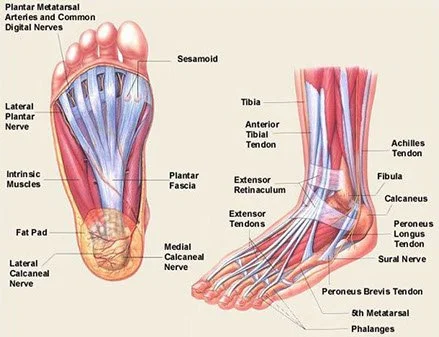Sandal season and foot pain…
‘Tis the season for foot pain… coincidence, I think not.
So now that it has warmed up, a few things happen…
1) you become more active (sometimes significantly increasing activity volume and load)
2) sandals are being worn to keep the foot cool
3) more barefoot and grounding time
4) you haven’t worked on spreading your toes and strengthening your foot instrinsic muscles
Let’s break down the anatomy and then I’ll provide you some tips…
The plantar fascia is an extremely tough band of fascia/ tissue, located on the bottom of the foot. It covers your tendons and converges into your arch and then hooks into the bottom of your heel (calcaneus bone) which then transitions into the achilles tendon. On the cadaver, it takes a sharp scalpel multiple attempts to break through it so the idea of tearing it is pretty unimaginable without significant trauma. However, when the intrinsic muscles on the bottom of your foot are not strong enough, your body is smart and will recruit the plantar fascia to tighten to help absorb shock. This tightening can cause pain and can alter the mechanical relationship with a bone spur. 1 out of 10 people have a heel spur, but only 5% with heel spurs have foot pain. We have to remember that the spur is not the root cause of plantar fasciitis so the pain can be treated without removing the spur.
When the plantar fascia tightens you need to remember that you have a fascia sheath that cover the bottom of your foot and back of your leg. It will start to tighten those other tissues down in the game of tug of war it is playing. Not helpful, but the body finds a work around.
This sounds like me, so what advice do you have…
There are a few things you can do to help avoid plantar fasciitis (bottom of the foot pain) and achilles tendon inflammation.
if you are wearing sandals- skip the thongs!!
Choose sandals with a back (even if it’s a sling back) so your toes don’t overwork to keep your foot in the shoe.
make sure your big toe is mobile.
if you need help, we can schedule a wellness/ injury prevention session to give you some customized mobility and exercises for your body.
start strengthening your intrinsic arch muscles to absorb the shock so your fascia does not have to.
make sure your shoe bends at the big toe joint and provides support on the inside & outside of the heel.
I always go over this with patients during our sessions and will give shoe suggestions based on their foot shape and needs.
5.
if you lack the motor control to separate and squeeze your toes, use toe spacers. I typically suggest these:
6. making sure you are training your foot to work properly through propulsion and gait cycle.
It helps to have someone assess how your posterior chain is functioning (back of the body in the photo above).
Most of all, do not suffer with foot pain.
During sessions, we can fully evaluate your foot, shoe wear, walking & running. We can provide detailed assessment, exercises and wedging/ orthotics in the shoes to correct dysfunctional movement (whether to treat pain, prevent injury or improve performance).
We only use wedging in the shoe and customize mold insoles if they are appropriate and supply you with specific details to help correct the root of your dysfunction. Orthotics can be used for someone with osteoarthritic or structural changes as well as helping with realignment while you strengthen to correct the mechanics.
“I use to battle plantar fasciitis daily. Thanks to your help and expertise, I have returned to running pain free and training for Boston Marathon.”
“Taking care of my foot and toe mechanics really helped offload all of my knee pain with golfing and playing with grandchildren.”
“I am most thankful for you remediating my foot issue. A year ago, I could hardly walk and pedaling was a pain.”
“You are a miracle worker! Or a shaman? Or the most intuitive person EVER! The little area on the top of my left foot with bad eczema is so much better because I took your advice. I have been trying to treat this for > 6 months. You’re a genius!”
This is not medical advice. You should always consult your healthcare practitioner(s) for medical advise and what is best for your care. The purpose of this blog is to centralize and share information while connecting with others.




